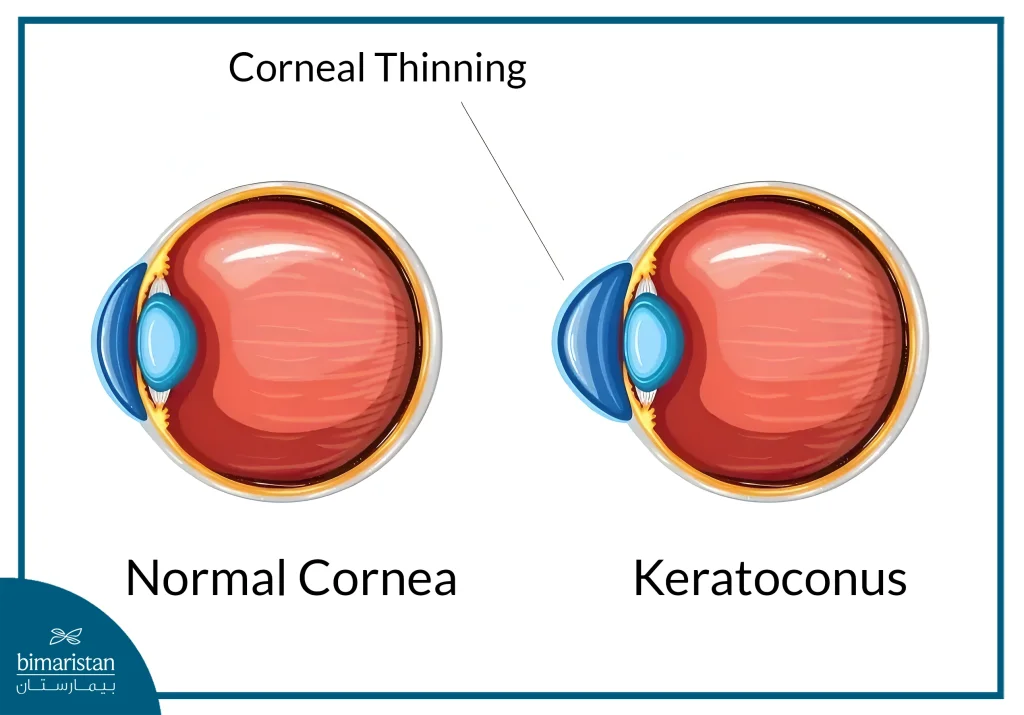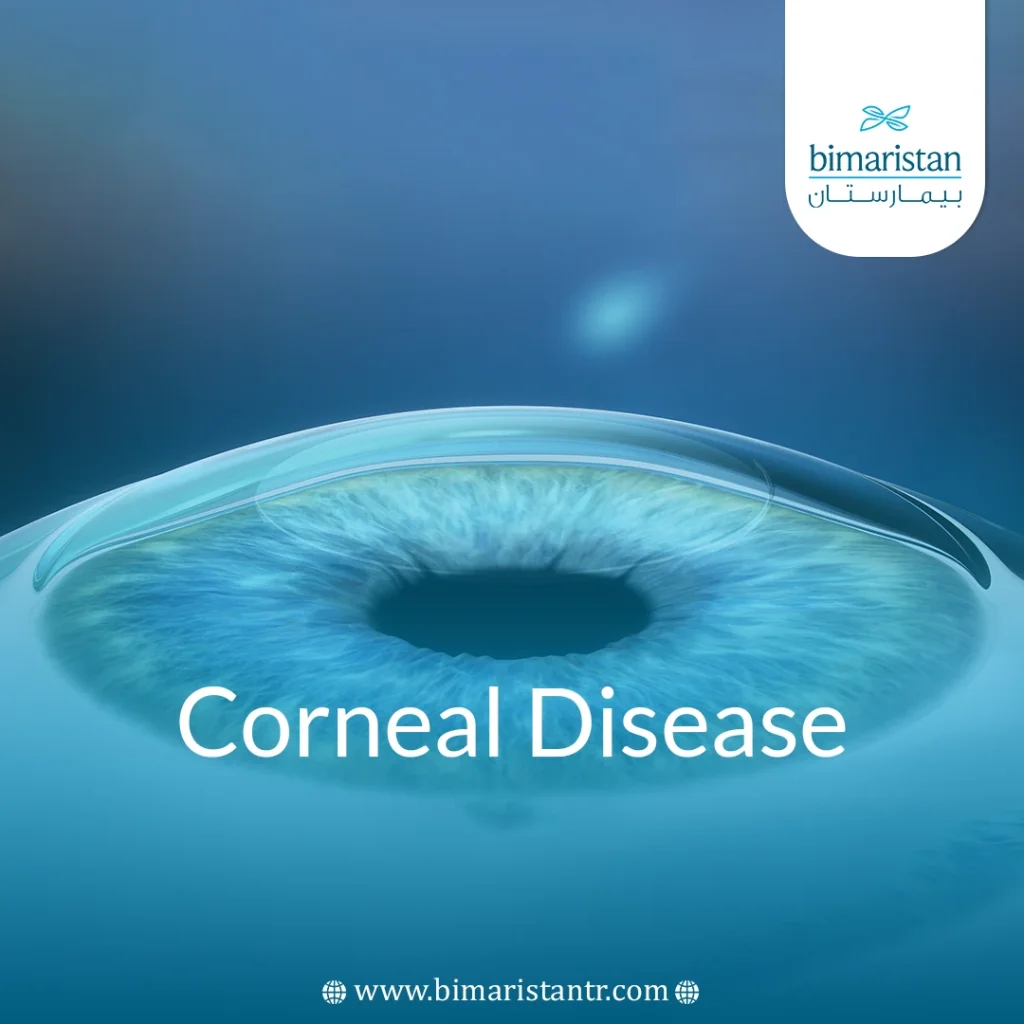Corneal disease is one of the most prominent issues affecting the eye, due to the vital role that the cornea plays as a transparent window that allows light to pass through and focus it on the retina. Any defect in its shape or transparency may lead to blurred vision or severe vision impairment. Since the cornea is considered the first line of defense for the surface of the eye, it is susceptible to injuries and damage. Fortunately, the cornea has a high capacity for rapid and effective self-healing. The effects of corneal disease range from simple eye irritation to partial or total vision loss, making early diagnosis and appropriate treatment critical to maintaining the quality of vision.
What is a cornea?
The cornea is the front transparent layer of the eye that covers the iris and the pupil. The cornea is the window through which light enters the eye, characterized by its convex shape and high transparency, which makes it responsible for refracting most of the light and focusing it on the retina, an essential step in forming a clear image.
The cornea plays a delicate role in vision, so any slight change in its shape or transparency, whether due to infections, scratches, or chronic diseases, can negatively affect the quality of vision. It is also rich in nerve endings, which makes it very sensitive to pain and irritation, explaining the discomfort of even minor superficial injuries.
What causes corneal disease?
There are many causes of corneal diseases, including:
- Infection (bacterial, viral, fungal, or parasitic)
- Injury or direct trauma to the eye
- Gene mutations or genetic factors
- Other ocular diseases
- Some general medical conditions
Types of common corneal diseases
The cornea is susceptible to injury, inflammation, and a range of diseases:
Keratitis
The microbial infection is known as a “corneal ulcer” and is often caused by bacteria, but viruses, fungi, and parasites may also be responsible. Non-infectious inflammation can be caused by eye injuries or conditions that dry out the surface of the eye. Common symptoms include eye redness, severe pain, excessive tears, sensitivity to light, and blurred vision, while non-infectious inflammation can occur as a result of eye injuries or conditions that dry out the surface of the eye.
Treatment depends on the type of causative agent, as antibiotics are given for bacterial infections, antivirals for viral cases, antifungals for fungal infections, and in some cases, cortisone drops are used under strict medical supervision to reduce inflammation.
Corneal ectasia
This is a group of conditions that cause the cornea to change shape, causing it to thin and bulge outward. Keratoconus is the most common form of this condition. This condition may appear as a complication after surgeries such as laser eye surgery (LASIK) or corneal transplantation. Initially, symptoms are not apparent, but they may gradually progress to affect vision and lead to serious complications such as corneal hydrops.
Keratoconus
Keratoconus is a condition in which the structure of the cornea gradually changes, becoming thin and taking a cone shape instead of the normal spherical shape, which leads to abnormal refraction of light and blurred vision, this condition is often due to genetic factors or a weakness in the structural collagen within the corneal tissue, the diagnosis is made by examining the topography of the cornea using advanced equipment such as topography, and treatment includes using rigid contact lenses to improve light focus, implanting rings inside the cornea to stabilize its shape and UV-irradiation (Cross- Linking) technique to strengthen the corneal tissue. Linking to strengthen the tissue, and corneal transplantation is used in advanced stages.

Corneal dystrophy
A group of genetic disorders that cause an abnormal buildup of proteins, fluids, or other substances in the layers of the cornea. Some of these types are progressive, meaning they get worse over time and can affect the quality of vision. Fuchs’ dystrophy is the most common type, but there are other types such as:
- Epithelial basement membrane dystrophy
- Retinal dystrophy
- Granular dystrophy
Corneal ulcers
Corneal ulcers are a serious complication. Corneal ulcers are often caused by a deep infection of the cornea or a superficial injury that is left untreated, the wrong use of contact lenses, especially when sleeping in them or not properly sterilized, is associated with a high risk of developing ulcers, prevention includes maintaining eye hygiene and not using lenses while symptoms of irritation are present.
Corneal opacity
Corneal opacity is the loss of its natural transparency as a result of deep wounds, severe infections or direct injuries such as chemical accidents, this condition leads to a reduction in the amount of light entering the eye and thus vision impairment in varying degrees, in case the opacity is superficial, it may be treated with lasers or specialized drops, while in severe cases, corneal transplantation is the best surgical option to restore vision.
Dry eye and its effect on the cornea
Dry eye is not classified as a major corneal disease, but it is one of the most common factors affecting its health. The cornea becomes irritated and dry when the quantity or quality of tears decreases, increasing the risk of abrasion and inflammation. Treatment includes using artificial tears regularly and avoiding dry or irritating environments. In some cases, tear duct plugs are used to maintain the natural lubrication of the eye.
Corneal injury and environmental factors
The cornea is similar to a car windshield in terms of its sensitivity. It is prone to scratches, tears, or ulcers as a result of accidents or external objects entering the eye. It can also be damaged by harsh environmental factors such as extreme cold or heat. Potential damage also includes corneal burns resulting from excessive exposure to ultraviolet rays or chemicals, whether liquid or gas, which may affect the integrity and function of the cornea.
What are the symptoms of corneal disease?
Symptoms vary depending on the type of condition, and may include:
- Mild to severe eye pain
- Sensitivity to light (photophobia)
- A feeling of a foreign body inside the eye
- Blurred or foggy vision
- Gradual deterioration of visual acuity over time
- Red or bloodshot eyes
- Increased tear production and discharge or pus from the eye
These symptoms are indicative of several possible conditions, and some corneal diseases may not show any symptoms in the early stages, so it is important to see your eye doctor if you experience any of these issues.
What are the risk factors for corneal disease?
The risk of developing certain corneal diseases is increased in the following cases:
- Presence of connective tissue diseases (such as lupus or rheumatoid arthritis)
- Weakened immune system
- Frequent eye rubbing, especially for those with seasonal allergies or eczema
- Previous eye surgery
- Wearing contact lenses, especially when worn for long periods or without proper sterilization
How is corneal disease diagnosed?
An ophthalmologist will diagnose corneal diseases through a comprehensive eye examination. This includes several standard tests such as the slit lamp examination to assess the health of the cornea and the rest of the eye. The doctor may also use a fluorescein dye test, where a small amount of a safe dye is placed inside the eye, and then a special light is shone to clearly show any scratches or damage to the surface of the cornea, after the examination the doctor will tell you if he noticed any issues and explain the next steps which may include referring you for treatment or appropriate specialties.
How is corneal disease treated?
Treatments for corneal diseases vary depending on the type and severity of the condition, with options ranging from simple treatments to complex surgical interventions. The most common treatments include the following:
- Artificial cornea: Used in advanced cases where traditional transplants are unsuccessful, an artificial cornea is transplanted to restore vision.
- Drug therapy: The use of eye drops, ointments, or topical medications to help reduce inflammation, fight infectio,n or promote tissue healing.
- Vision correction aids: Eyeglasses or corrective contact lenses to improve the quality of your vision.
- Laser treatment: Phototherapeutic Keratectomy, which is used to remove damaged surface layers of the cornea to improve its shape and function.
- Corneal transplant: A procedure in which the damaged part of the cornea is replaced with a healthy cornea taken from a donor.
Finally, corneal disease includes diverse conditions that vary in severity and impact on vision, but thanks to medical advances, effective treatment options are now available that contribute to restoring vision and improving quality of life. Early diagnosis and regular follow-up with an ophthalmologist remain the key to maintaining corneal health and vision.
To check on the health of your eyes or for a specialized consultation, we invite you to visit Bimaristan Center, where you will be provided with the highest standards of medical support by a group of specialized doctors.
Sources:
- National Eye Institute. (n.d.). Corneal conditions. U.S. Department of Health & Human Services
- American Academy of Ophthalmology. (n.d.). Eye symptoms list
